It’s a Jungle Out There: Monkey Jungle
With Florida’s long list of defunct tourist attractions getting longer every day, we are fortunate that some smaller venues still survive. Monkey Jungle is one of those more laid back attractions that still manage to entertain without thrill rides, stage shows, or 3-D presentations. The formula is a simple one, if you like monkeys then you will love Monkey Jungle.
The History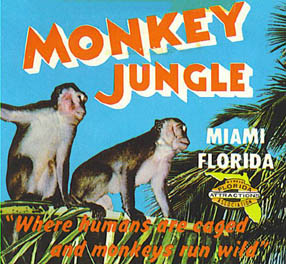
Monkey Jungle was founded in 1933 by Joseph and Grace DuMond. The couple purchased ten acres of land in South Florida and released a small group of Macaque monkeys (also known as crab-eating monkeys) into the trees for study. To fund the project, they soon began charging ten cents admission to the interested locals who had heard about the free roaming primates. Screen covered walkways were eventually added to protect the visitors from harm if they were perceived as intruders by the territorial monkeys.
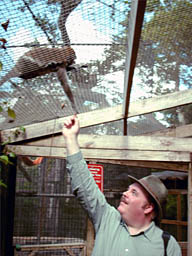 In 1955, Joe DuMond’s son Frank became the director of the project and began to expand the park to include new scientific study programs and attractions for the general public. This included the creation of a four acre Amazonian rain forest complete with native monkeys. The vegetation thrived in the South Florida sun and the canopy of plants became so thick that it created its own ecosystem and climate. During this period, other primates like Bulu the Gorilla and trained chimp shows were added to entice tourists who had come south to visit the beaches.
In 1955, Joe DuMond’s son Frank became the director of the project and began to expand the park to include new scientific study programs and attractions for the general public. This included the creation of a four acre Amazonian rain forest complete with native monkeys. The vegetation thrived in the South Florida sun and the canopy of plants became so thick that it created its own ecosystem and climate. During this period, other primates like Bulu the Gorilla and trained chimp shows were added to entice tourists who had come south to visit the beaches.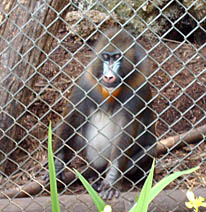
Hurricane Andrew caused major devastation to the park in 1992, destroying many of the fixtures and most of the vegetation. The larger primates were moved to safety but many of the smaller ones weathered the storm just like they would in the wild. The rain forest was rebuilt but it is estimated that it will take another ten years before it returns to its former luster.
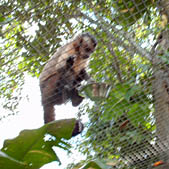 Monkey Jungle is also the home of a variety of exotic birds and reptiles. While rarer species are kept in pens, many lizards roam free in the trees and along the fence lines just like the monkeys. The park also features a program for captive parrots that can no longer be cared for by their owners. The birds are housed with compatible species in free flight cages that allow them room to fly.
Monkey Jungle is also the home of a variety of exotic birds and reptiles. While rarer species are kept in pens, many lizards roam free in the trees and along the fence lines just like the monkeys. The park also features a program for captive parrots that can no longer be cared for by their owners. The birds are housed with compatible species in free flight cages that allow them room to fly.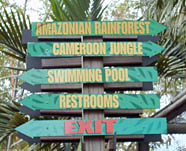
The Experience
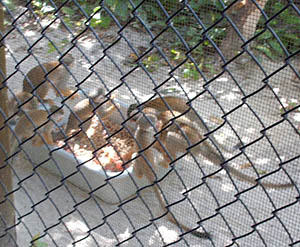 To me, the most enjoyable aspects of Monkey Jungle are the low key environment of the park and the enthusiasm of the staff. On a recent trip with my friend Memphis Phil Patterson, we were the first visitors to arrive around 10:30 in the morning and had the park to ourselves for about an hour. We had just missed the feeding show for King the Gorilla but his handler, Rickey, invited us back anyway and even let us toss King his morning sustenance of fruit and bottled unsweet ice tea! We found out that King, who was purchased from a circus when he was 10, is 38 years old now which would just about be the end of his natural life span in the wild. He will live much longer in captivity though and suffers from some of the same complaints older humans do. He has cataracts in both eyes (they are currently searching for an Optometrist willing to operate) and arthritis in one leg. He also dislikes his neighbors and regularly throws iguanas into his mote for trying to steal his food!
To me, the most enjoyable aspects of Monkey Jungle are the low key environment of the park and the enthusiasm of the staff. On a recent trip with my friend Memphis Phil Patterson, we were the first visitors to arrive around 10:30 in the morning and had the park to ourselves for about an hour. We had just missed the feeding show for King the Gorilla but his handler, Rickey, invited us back anyway and even let us toss King his morning sustenance of fruit and bottled unsweet ice tea! We found out that King, who was purchased from a circus when he was 10, is 38 years old now which would just about be the end of his natural life span in the wild. He will live much longer in captivity though and suffers from some of the same complaints older humans do. He has cataracts in both eyes (they are currently searching for an Optometrist willing to operate) and arthritis in one leg. He also dislikes his neighbors and regularly throws iguanas into his mote for trying to steal his food!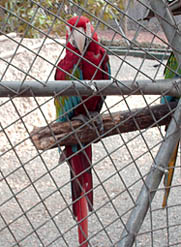
Our next stop was the restored Amazon rain forest for the monkey feeding. The guide, Andrew, gave us the run down on the different species of monkeys that live together in the rain forest habitat. The park provides the primates with about forty percent of their daily caloric intake. The rest of their diet, which consists of plants, insects, and small reptiles (moneys are omnivores), is provided by the forest just like it would be in the wild. The South American rain forest area was originally open to the public and they could walk among the lush vegetation. Unfortunately, it had to be sealed off several years ago when too many visitors were trying to steal the monkeys!
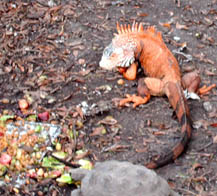 Andrew also presided over the monkey swimming pool show where a tribe of Macaques joins the public on the banks of a small river in search of treats. These monkeys have a very organized social structure and the alpha males are allowed the best places to sit and first crack at any food offered to them. They also have no fear of water or getting wet. Apparently hard boiled eggs are a delicacy for these primates and they will swim underwater to retrieve them, doing what the park refers to as “monkey skin diving”.
Andrew also presided over the monkey swimming pool show where a tribe of Macaques joins the public on the banks of a small river in search of treats. These monkeys have a very organized social structure and the alpha males are allowed the best places to sit and first crack at any food offered to them. They also have no fear of water or getting wet. Apparently hard boiled eggs are a delicacy for these primates and they will swim underwater to retrieve them, doing what the park refers to as “monkey skin diving”.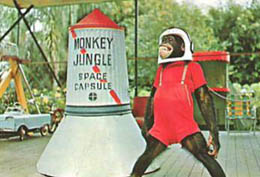
The chimpanzees, that were once a very popular attraction at Monkey Jungle, were phased out about ten years ago under uncertain circumstances and their absence is conspicuous. According to Andrew, this oversight should be corrected in the next six months or so. The park has purchased three chimps and is working to renovate the original habitat to support the new tenants. Andrew showed me what was once the chimp area and it looks like the revived attraction will be very impressive. Hopefully it won’t take long for them to have chimps imitating the Beatles and NASA astronauts again!
Monkey Jungle is also home to another incredibly rare species – the Mold-A-Rama souvenir making machine! The park has two prime working examples of this nearly extinct breed that once thrived in almost every tourist attraction in the country. The machines injection mold a small souvenir statue right before your eyes and drops the piping hot plastic keepsake into a dispensing slot. I remember these machines being the highlight of many otherwise boring tourist stops as a kid but now they are considered outdated by today’s computer and video game obsessed youngsters. I appreciated the opportunity to relive a portion of my youth as I paid the now $2.00 price tag to mold my own small gorilla and three monkeys statues authentically stamped with the Monkey Jungle logo!
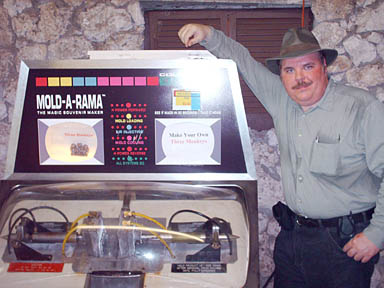 While I was being fascinated by the Mold-A-Rama machines, Memphis Phil returned to the entrance area to visit with the parrots. He got particularly friendly with a Hyacinth Macaw and even had it speaking. This beautiful blue bird is the largest species of parrot and even though we were assured it had just had its claws and beak trimmed, it still looked formidable to me. Phillip was about to try and talk the staff into selling it to him when I reminded him he would never get it on the plane back to Memphis.
While I was being fascinated by the Mold-A-Rama machines, Memphis Phil returned to the entrance area to visit with the parrots. He got particularly friendly with a Hyacinth Macaw and even had it speaking. This beautiful blue bird is the largest species of parrot and even though we were assured it had just had its claws and beak trimmed, it still looked formidable to me. Phillip was about to try and talk the staff into selling it to him when I reminded him he would never get it on the plane back to Memphis.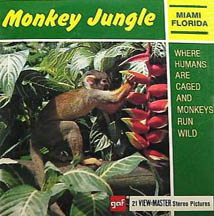
We spent about three leisurely hours at the park and could have easily stayed longer if the call of lunch had not seemed like such a great idea. My only complaint for the visit is that the gift shop is sparsely stocked and most of the souvenir items are just monkey themed while not being actual Monkey Jungle merchandise. I was disappointed that I could not get a T-shirt or patch to commemorate the visit. The staff was extremely friendly and knowledgeable about the park and its inhabitants which is not to be taken for granted these days. There were never more than a dozen other visitors with us at any time and I was told this was a typical crowd for this time of year during the week. The park remains a popular stop for tourists on summer vacations as well as school field trips during the fall. For anyone in South Florida who enjoys nature (and, of course monkeys!), Monkey Jungle is highly recommended.
Strange Coincidence Department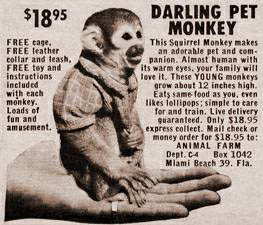
While I was talking to Ricky about the park’s primate selection, I was reminded of the old comic book ads that offered squirrel monkeys to children (with guaranteed live delivery no less). Somehow I never managed to scrape up the $18.95 required or I would have tried to mail it all in loose change as soon as my parents’ backs were turned! He had never heard of such advertisements and was shocked that monkeys were once sold mail order since the regulations these days are so strict. When I dug up one of these ads for this article, I was surprised to learn that the headquarters of this particular venture was Miami,Florida! This advertisement is from 1966 and it makes me wonder if Monkey Jungle had a side business going back then selling off their excess inventory!
